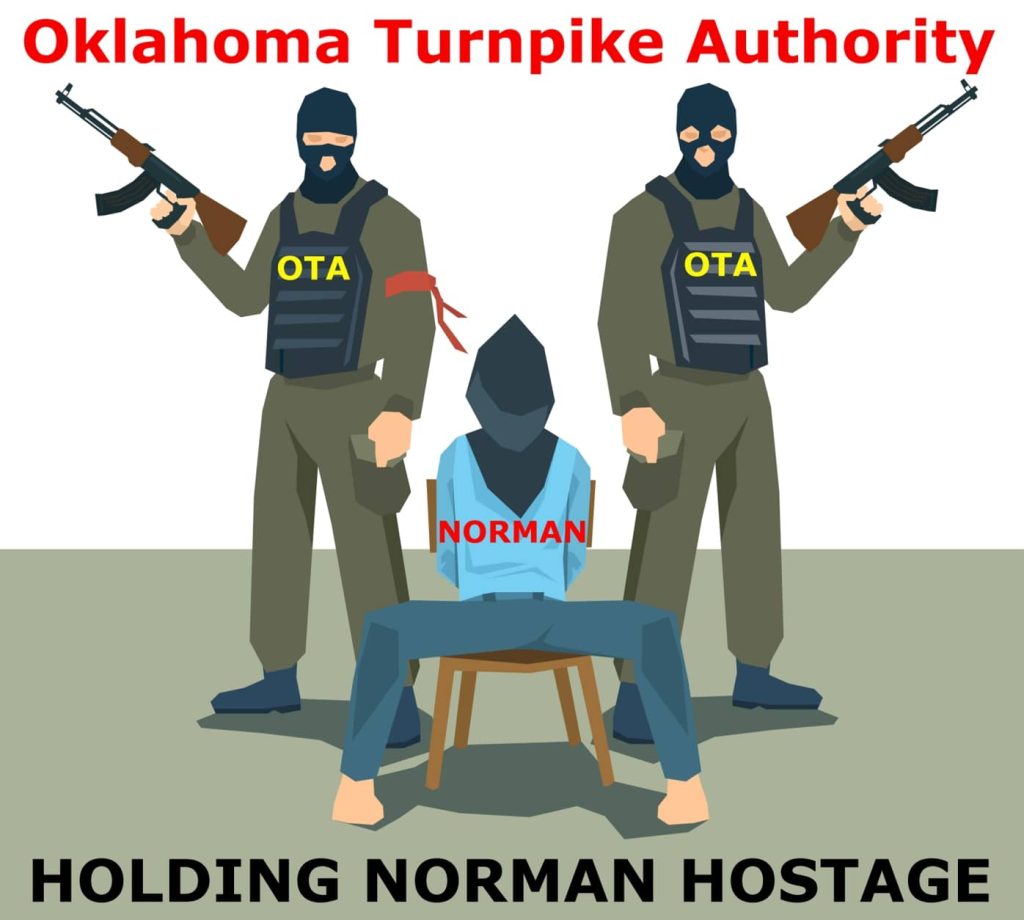The Oklahoma Turnpike Authority (OTA) that exists today is far from the version that your grandparents might remember.
For them, the Turner Turnpike was a symbol of convenience—a wide, affordable route to Tulsa and beyond. What wasn’t to love about an easy way to travel long distances?
Unfortunately, that was the past, and now, the OTA is hardly what it once was. Today, it resembles more of a criminal cartel—run by scammers, opportunists, and corrupt officials. Recent events have exposed their true nature. Controlled by groups of developers, contractors, bankers, and politicians, the OTA is part of the growing “development at any cost” corporate welfare movement that only cares about making money, with little regard for the damage they cause to achieve it.
WHY NORMAN?
This Article Includes
The OTA views Norman as key to saving Oklahoma’s struggling turnpike system. With only three of their eleven turnpikes turning a profit, the OTA sees new toll roads around Norman as part of their “ACCESS Oklahoma” project to support their shaky operations.
If you haven’t been following the drama, the city of Norman has been embroiled in a heated battle with the OTA over plans to construct over 50 miles of toll roads, designed for speeds of 90 miles per hour and six lanes wide. These roads would cut through Norman, including a major disruption along Indian Hills Road, which marks the city’s northern boundary.
The consequences of these toll roads are nothing short of catastrophic. The North-South route, stretching from Purcell to southeast Oklahoma City, would sever Norman in half, running through its vital watershed and Lake Thunderbird easements—Norman’s primary water supply. In January 2023, the Bureau of Reclamation (BoR) rejected the OTA’s request to build along these easements, but the OTA has yet to submit an alternative plan.
The East-West route, involving a nearly two-mile bridge across the South Canadian River, would cause even more harm, permanently altering floodplains, wetlands, and habitats for protected wildlife.
The human cost is staggering as well. Over 600 families would face displacement through eminent domain, not for a public good, but to serve private interests. The OTA has fabricated traffic projections to justify these roads as “relievers” for traffic congestion. However, closer scrutiny reveals these projections to be not just inaccurate, but misleading.
CURRENT STATUS
Starting in July 2024, the OTA, aided by Norman Mayor Larry Heikkila and City Manager Darrell Pyle, pushed various resolutions to the City Council, aiming to gain approval for the turnpikes. The Council rejected these resolutions, with the latest version being postponed on October 22 until a public meeting could be held, allowing citizens to question OTA officials.
OTA REFUSES TO ENGAGE
Predictably, the OTA refused to participate in such a meeting. Public scrutiny was not something they were willing to tolerate. According to City Manager Pyle, after the Council’s rejection of their resolution, the OTA decided to proceed with their plans to build the toll roads—but without providing any access points or frontage roads in Norman, essentially cutting off the city from the turnpikes.
OTA’S BANKRUPT BUDGET AND MASSIVE TOLL INCREASES
Opponents of the toll roads, including citizens’ groups like Pike Off OTA and Oklahomans for Responsible Transportation, have pointed out that the ACCESS Oklahoma project’s costs are ballooning. According to a recent report, construction costs have risen 15% annually since 2019. As a result, the project, initially estimated at $5 billion, is now projected to cost $8.2 billion—an increase of over 60%.
During an interview on November 7, OTA Executive Director Joe Echelle claimed, “The turnpike authority’s business model is that we sell bonds, build a turnpike, charge tolls and pay off the bonds.”
However, this statement is a lie. The OTA has never allowed any bond to fully mature and be paid off. Instead, they rely on a scheme called “cross-pledging” and continually refinance existing bonds, trapping the agency in a perpetual cycle of debt.
The OTA is proposing to increase their long-term debt from $2.1 billion to over $10 billion—almost the size of Oklahoma’s entire state budget. With little additional revenue expected from the new toll roads, the OTA could soon need to raise toll rates by 100% to cover debt payments. In the worst case, tolls could increase by as much as 300-400%. This would mean tolls for cars could soar from $9 to $35 or more, while trucks could face fees as high as $150.
WHAT’S NEXT?
To move forward with their plans, the OTA needs approval from Oklahoma’s Council of Bond Oversight (COBO), which is scheduled to meet on December 5. Will COBO see through the OTA’s scam, or will they rubber-stamp the project, as is often the case with Oklahoma’s government agencies? Time will tell.
